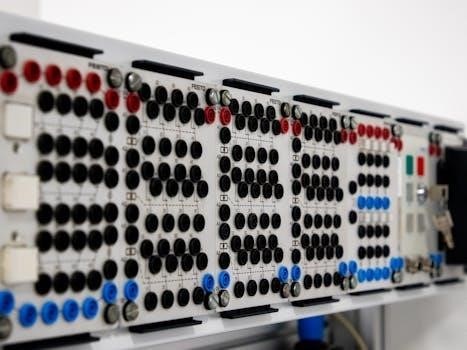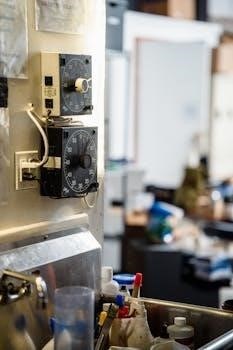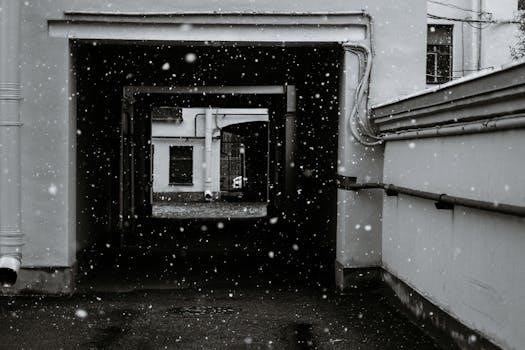three way switch wiring diagram pdf
Understanding 3-Way Switch Basics
A 3-way switch allows control of a light from two locations, enhancing convenience. These switches differ from standard ones by having two traveler terminals. This configuration needs a specific wiring setup for proper functionality.
What is a 3-Way Switch and Its Function
A 3-way switch is a specialized electrical switch designed to control a light fixture, or other electrical load, from two separate locations. Unlike a standard single-pole switch, which simply breaks or completes a single circuit, a 3-way switch uses a more complex arrangement of terminals and internal connections. These switches feature three terminals⁚ one common terminal and two traveler terminals. The common terminal is where the power source enters or exits the switch, while the traveler terminals serve as pathways to the other switch in the circuit. The primary function of a 3-way switch is to allow the user to turn a light on or off from either of the two locations, making it ideal for stairways, hallways, and large rooms with multiple entrances. It’s important to understand that a 3-way switch doesn’t have a dedicated “on” or “off” position, but rather toggles between different states to control the light.

Common 3-Way Switch Wiring Configurations
There are several common ways to wire 3-way switches, including power to first switch, power to light fixture, and power through light setup. Each has specific wiring paths.
Power Source to First Switch
In this configuration, the power from the electrical panel directly feeds into the first 3-way switch. Typically, a 2-wire cable brings the power, with the black wire (hot) connected to the common terminal of this switch. The white neutral wire is often capped off and not used at this point in the circuit. From here, the power is then distributed to the second switch and ultimately the light fixture. This is a common way to start the wiring sequence, and careful attention to the connections at the first switch is needed to make sure everything functions properly. The ground wire will also be present.
Power Source to Light Fixture
In another common setup, the electrical power first enters the light fixture box. Here, the black hot wire is connected to one of the terminals of the light fixture. From this point, the circuit is extended to the first 3-way switch using a 3-wire cable. The white neutral wire is connected directly to the fixture, and the other wires are for controlling the switch actions. This method requires careful wiring at the light box to ensure proper circuit flow. The traveler wires connect to the light fixture to allow switching from both locations.
Power Through Light Setup
A “power through light” configuration has the electrical feed first going to the light fixture’s junction box. This method differs from the power-to-switch setup because the initial wiring point is at the light itself. One of the wires from the power source connects to the light fixture, and the other wire continues to the first 3-way switch. From the first switch, a 3-wire cable is used to run to the second switch. This configuration is common when the power source is close to the light and makes the wiring through the light, and the switch is necessary, requiring careful attention to wire connections within the light box.
Wiring Diagram Details
Understanding wiring diagrams is crucial for 3-way switch installations. These diagrams show the connections between switches, power source, and light. They also help identify the common terminals and traveler wires.
Identifying Common Terminals on Switches
Locating the common terminal on a 3-way switch is the first step in wiring. This terminal is usually a different color than the other two, often black or a darker color, and sometimes marked with the word “common” or “com”. It’s crucial to identify this terminal because it’s where the power source or the wire going to the light fixture will connect. The other two terminals are for the traveler wires and they are typically brass or silver in color. Switch manufacturers may place the common terminal on top or bottom. Therefore, it is important to always check the switch itself. Do not rely solely on diagrams. Correctly identifying the common terminal is essential for proper 3-way switch operation and electrical safety.
Understanding Traveler Wires
Traveler wires are the key to 3-way switch functionality, connecting the two switches and allowing for control from either location. These wires are not directly connected to the power source or the light fixture, but rather they switch the circuit between the two switches. Typically, there are two traveler wires, often red and another color, which alternate the path for electricity. This switching action enables either switch to turn the light on or off, regardless of the state of the other switch. The traveler wires must be connected to the correct traveler terminals on each switch for proper operation. Miswiring can result in a non-functional circuit, so careful attention is required.
Color Coding of Wires (Black, Red, White, Ground)
Understanding wire color codes is crucial for safe and correct 3-way switch wiring. Black wires usually carry the hot, or live, power from the electrical panel. Red wires often serve as travelers in 3-way circuits, connecting the two switches together to alternate the current; White wires are typically neutral, completing the electrical circuit. Bare copper or green wires are for grounding, providing a path for stray electricity. It’s very important to note that while these are common uses, local electrical codes must be followed. Always double-check the function of a wire using a multimeter before making any connections. Proper color coding is essential for easy identification during both installation and future maintenance.

Practical Wiring Scenarios
3-way switches are very useful in several settings. They are commonly used for multiple lights and stairways. Understanding these common scenarios allows for efficient and safe installation in various situations.
Wiring with Multiple Lights
When wiring a 3-way switch system to control multiple lights, the setup is a little different from wiring a single light. Instead of the traveler wires going directly to a single light fixture, they are routed to a junction box. This box serves as a central point for the additional lights. From the junction box, each light is wired in parallel using standard methods. This means that the hot wire is split to each light. The neutral wires are also connected together. This parallel wiring ensures that each light receives the necessary power to operate. The traveler wires still go from one 3-way switch to the other. This method allows all the lights to be turned on or off from either switch location. It’s crucial to use wire nuts or terminal blocks within the junction box for safe connections. Proper insulation of each connection must be maintained to prevent short circuits. When wiring this, be sure the connections are tight, and do not overload the circuit.
Wiring for Stairway Lighting
Wiring for stairway lighting is a very common application of 3-way switches. This setup allows you to turn on the lights at the bottom of the stairs and turn them off at the top, or vice-versa. The wiring is similar to a standard 3-way setup, with one switch at the top of the stairs and one at the bottom. The power source usually enters the first switch box. The traveler wires connect the two switches, enabling control from both locations. The light fixture is wired to one of the switches, typically the one at the end of the circuit. This method eliminates the need to walk through a dark stairway. It provides safety and convenience. When wiring, be sure to follow the established color codes for each connection. This is important for safety. Be sure to double-check all connections before turning power on. Using a multimeter to test the circuit is a good practice.

Advanced Topics
Exploring advanced topics includes automated hardwired and smart 3-way switches. These utilize technology for remote control and offer additional features. They often require neutral wires and proper setup.
Automated Hardwired 3-Way Switches
Automated hardwired 3-way switches represent a significant step in modern lighting control. These devices integrate seamlessly into existing electrical systems, providing the convenience of remote operation for lights controlled from multiple locations. The wiring requirements often involve not only the standard traveler wires but also a neutral wire, which is essential for powering the switch’s internal electronics. This makes the installation slightly more complex than traditional switches, requiring careful attention to the wiring diagram. These switches can often be integrated into smart home systems, allowing for scheduling, voice control, and other advanced features. This integration enhances home automation and offers greater control over lighting, which can improve security and reduce energy consumption. It’s crucial to consult the manufacturer’s specific wiring diagram when installing these switches. Proper installation ensures the switch operates correctly and safely.
Smart 3-Way Switch Installation
Installing smart 3-way switches introduces a new level of sophistication to home lighting control. These switches often require a neutral wire, a critical factor to consider during installation. The process may involve identifying the common terminal on each switch, as well as the traveler wires, which link the two switches. Unlike traditional 3-way switches, smart versions frequently need a constant power source to function, which is where the neutral wire comes in. Smart 3-way switches are typically designed to connect to Wi-Fi, enabling remote access and control through smartphone apps or voice assistants. This added layer of technology allows for scheduling, dimming, and other advanced features. Therefore, adhering to the specific wiring diagram provided by the manufacturer is paramount for a safe and successful installation. It is also advisable to double-check all connections before restoring power to the circuit.

Safety Considerations
Ground connections are crucial for safety, preventing electrical shocks. Always verify wiring with a multimeter before use. Turn off power at the breaker before starting any work.
Importance of Ground Connections
Ground connections are absolutely paramount in electrical wiring, especially when dealing with 3-way switch circuits. The ground wire, typically bare copper or green insulated, acts as a safety pathway for errant electrical current. Without a proper ground, any fault in the system could cause a dangerous buildup of electricity, potentially leading to electrical shock, fire, or damage to equipment. A reliable ground connection ensures that in the event of a short circuit or other electrical anomaly, the excess current is safely redirected to the earth. This is extremely important for protecting individuals and property. It is not a functional part of the circuit but an essential safety measure. Always ensure all ground connections are securely fastened.
Checking Connections with a Multimeter
After wiring a 3-way switch, a multimeter is essential for verifying connections. Using the multimeter in continuity mode helps confirm that the wires are correctly connected and that the circuit is complete. When testing, ensure the power is off. Check that the hot wire is correctly connected to the common terminal and the traveler wires are on their proper terminals on both switches. Measure the continuity of the ground wires to confirm they’re properly connected. Use voltage mode to verify power is present only where expected and that no unexpected voltage is present. A multimeter is crucial for diagnosing wiring issues and ensuring safe and functional 3-way switch installation. Always follow proper safety procedures. This will assist in confirming the wiring matches the 3-way switch wiring diagram.